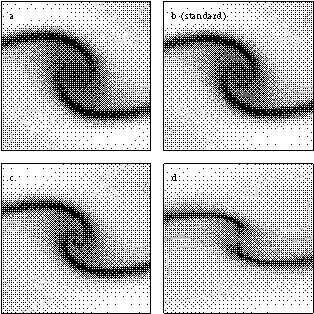


4.8. Nuclear Spirals in Disk Galaxies
When the mass is concentrated towards the center in a galaxy, there can be several possibilities and mechanisms to fuel the nucleus: either bars within bars, as multi-mode stellar density waves, as described previously, or an instable gas-dominated central disk (Heller & Shlosman 1994). Another possibility is simply a large-scale stellar bar, and a gaseous nuclear spiral by continuity. It has been indeed proposed that the observed nuclear spirals are only gaseous (Elmegreen et al 1998, Regan & Mulchaey 1999). They could be acoustic waves, developing without self-gravity. Gas short waves are able to propagate inside ILR (and beyond OLR outside). The dispersion relation is (with vs the sound speed):

for m = 2

if kR >> 1, the gas waves propagate only when
( -
-
 / 2 >
/ 2 >
 p,
in between two ILRs, or if there is only one ILR.
Multi-arms (large m) are possible. The value of Q is
large, since the gas is not self-gravitating.
Simulations show the gas response in a stellar bar potential,
and how the morphology depends on the sound speed and
on the shape of the potential
(Englmaier &
Shlosman 2000,
cf fig 12).
p,
in between two ILRs, or if there is only one ILR.
Multi-arms (large m) are possible. The value of Q is
large, since the gas is not self-gravitating.
Simulations show the gas response in a stellar bar potential,
and how the morphology depends on the sound speed and
on the shape of the potential
(Englmaier &
Shlosman 2000,
cf fig 12).

|
Figure 12. Gas streaming in a barred potential. The stellar bar is horizontal and extends more than twice the size of the box. The different morphologies are due only to the different values of the sound speed: (a) 7 km/s, (b) 10 km/s, (c) 14 km/s, (d) 20 km/s, from Englmaier & Shlosman (2000). |